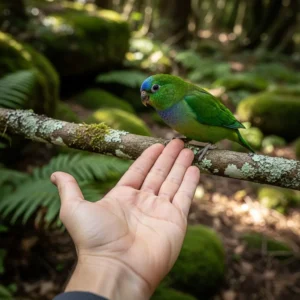
Feathered Companions: The Joy of Keeping Birds as Pets
For those seeking a different kind of companionship, birds offer intelligence, beauty, and song. Keeping birds as pets can fill a home with life and sound, providing a cheerful presence for seniors who spend a lot of time at home. Their care is primarily centered around their enclosure, making them a good option for people with limited mobility. A bird’s cheerful chirping or melodic song can be a constant, comforting presence in a quiet house.
It is crucial, however, to approach bird ownership with realistic expectations. Birds are not simple, decorative additions to a room. They are intelligent, social creatures that require daily interaction, a specialized diet, and a meticulously clean environment to thrive. They can be messy, scattering seeds and feathers around their cage. Some species can also be quite loud. Choosing the right species is essential to ensure a successful and happy relationship for both bird and owner.
Best Bird Species for Senior Lifestyles
For seniors, smaller and quieter bird species are generally the most suitable. Their housing needs are more manageable, and their vocalizations are less likely to be disruptive.
Budgerigars (Budgies): These small parrots are a classic choice for a reason. They are intelligent, playful, and can form strong bonds with their owners. Their chattering is generally pleasant and not overly loud. With patience and positive reinforcement—a training method that rewards desired behaviors—they can be hand-tamed and even learn to mimic words. Their typical lifespan of 5 to 10 years is a more manageable long-term commitment than that of larger parrots.
Canaries: If you desire the beauty and sound of a bird without the demand for hands-on interaction, a canary is an excellent choice. Male canaries are renowned for their beautiful, melodic songs. They are content to live singly and are best enjoyed as observational pets. Their care is straightforward: a clean cage, fresh food and water, and the occasional bath.
Finches: Like canaries, finches are hands-off pets. They are small, quiet, and must be kept in pairs or small groups as they are highly social with their own kind. The gentle, constant peeping of a flock of Zebra or Society finches can be very soothing. Watching their busy social interactions provides endless, calming entertainment.
Cockatiels: Slightly larger than budgies, cockatiels are known for their gentle, affectionate personalities. They are intelligent and can be trained to whistle tunes and step onto a finger. However, they can be quite dusty and their screech can be loud, which may be a consideration in apartment living. Their longer lifespan of 15 to 20 years represents a significant commitment.
Creating a Safe and Stimulating Bird Environment
A bird’s health is directly tied to its environment. Daily husbandry is non-negotiable and includes providing fresh food and water and changing the liner at the bottom of the cage. A full cage cleaning, scrubbing perches and toys, should be done weekly.
Nutrition is another critical area. An all-seed diet is a common cause of malnutrition and illness in pet birds. Avian veterinarians, whose expertise can be found through organizations like the Association of Avian Veterinarians (AAV), recommend a diet based on formulated pellets, supplemented with a small amount of seeds and a daily offering of bird-safe fresh vegetables like chopped kale, bell peppers, and carrots.
Bird safety at home extends beyond the cage. Birds possess an extremely sensitive respiratory system. Fumes from non-stick cookware (Teflon), aerosol sprays, scented candles, and strong cleaning products can be toxic and even fatal. These items should never be used in the same room as a bird. A bird-proofed room is also necessary for any out-of-cage time, ensuring windows and doors are closed, ceiling fans are off, and other pets are secured.
A simple enrichment plan can keep a bird mentally healthy. Here is a mini-example for a pet budgie:
Morning (10 minutes): While changing food and water, talk softly to the bird. Introduce a new, simple foraging toy, like a piece of cardboard with a seed tucked inside.
Afternoon (15-20 minutes): During a quiet time of day, allow supervised time out of the cage on a play stand placed near your armchair. This allows for social time without demanding constant handling.
Evening (30 minutes): Play soft classical music or a nature sounds recording near the cage to provide auditory enrichment before covering the cage for the night.















